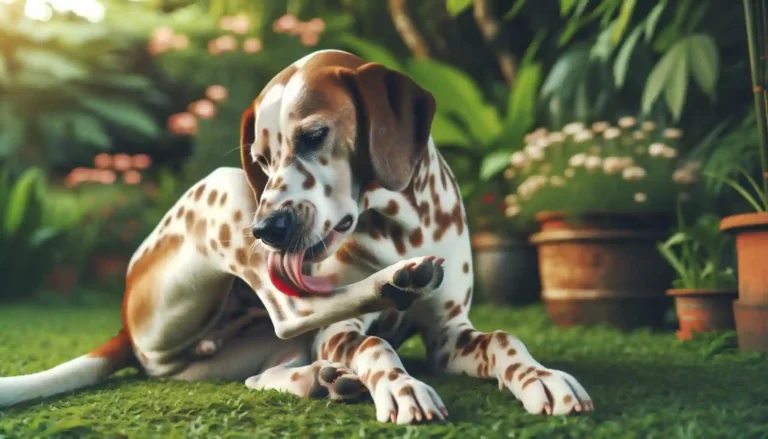Introduction
Welcome to a deeper dive into a strange but surprisingly common behavior observed in our canine companions: excessive foot licking. Have you ever been surprised to find your furry friend constantly licking your feet, yet there is nothing there? you’re not alone! This behavior, although often perplexing dog owners, is a widespread phenomenon in the dog world.
Understanding Dog Licking Behavior
Getting into the world of dogs, licking is as much a part of their nature as wagging their tails or chasing balls. But why do they do this, and when does it fall within the scope of concern? let’s explore.
Why do dogs lick themselves?
- Natural Instinct: Licking is a natural instinct of dogs. This is part of their self-grooming process, helping them clear dirt and debris from their fur and skin.
- Healing Process: Dogs instinctively lick their wounds. Their saliva contains enzymes that can help clean and heal small injuries.
- Relaxation and Pleasure: Licking releases endorphins in dogs, causing a feeling of relaxation and pleasure. This is their way of self-soothing.

Normal vs Excessive licking
- What is normal? : Occasional licking, especially after meals or during grooming, is normal behavior for dogs.
- Symptoms of Excessive Licking: If your dog is constantly licking causing redness, bald spots or sores, it is a sign that the licking is excessive.
- Observation is key: Monitoring the frequency, duration, and intensity of your dog’s licking behavior is key in distinguishing normal grooming from a potential problem.
Nature and Beauty in Licking
- Grooming Rituals: Dogs often lick themselves as part of their grooming ritual, cleaning hard-to-reach areas and maintaining coat health.
- Instinctive Behavior: Licking is an instinctive behavior passed down from their wolf ancestors, who licked themselves for both cleaning and wound care.
- Comfort in Routine: Routine grooming, including licking, provides a sense of comfort and routine for dogs, reinforcing their instinctive behaviors.
Possible Causes of Excessive Licking
Moving beyond basic care, when a dog constantly pays attention to his feet, it may be a sign of underlying problems. These can be broadly classified into psychological, medical and environmental factors.

Psychological Factors
- Stress and Anxiety: Like humans, dogs can exhibit stress and anxiety. One way they express this is through repetitive behavior, such as focusing intently on their limbs.
- Boredom: Dogs may engage in this behavior as a means of keeping themselves busy due to a lack of mental and physical stimulation.
- Compulsive Behavior: In some cases, this action can develop into a compulsive habit, which often requires behavioral intervention.
Medical Reasons
- Allergies: Allergic reactions, whether food-related or environment-related, can cause discomfort, leading to excessive attention to the feet.
- Skin Infections and Irritation: Various skin conditions, including infections and dry skin, can cause itching and discomfort, prompting dogs to soothe the area through this behavior.
- Arthritis and Pain: Older dogs, or those who have joint problems, may focus on their feet due to pain or discomfort associated with conditions such as arthritis.
Environmental Factors
- Irritants: Chemicals or external pollutants in cleaning products can irritate a dog’s skin, leading to increased grooming behavior.
- Changes in the Home: Dogs are sensitive to their environment. Changes such as a new pet, a new family member, or even a change in routine can cause stress, which manifests in a variety of behaviors, including excessive grooming.
Identifying Signs of a Problem
Recognizing when your dog’s grooming behavior crosses the line into something concerning is key to ensuring their health and happiness. Here are ways to recognize if behavior is excessive and needs attention.
Indicators of Excessive Grooming
- Duration and Frequency: If your dog spends a large part of his day focusing on his feet, or if you notice that this behavior has become more frequent, it is a sign to take a closer look.
- Interference with Daily Activities: When this behavior interferes with their regular activities such as eating, playing or resting, it is a sign that the behavior is excessive.

Visible Symptoms
- Redness and Irritation: Repeatedly focusing on the same area can cause skin irritation, evidenced by redness or swelling.
- Hair Fall: Excessive grooming leads to hair fall, which leads to bald spots on the legs.
- Skin Lesions: In severe cases, this can lead to sores or open wounds, increasing the risk of infection.
Behavioral Symptoms
- Obsessive Focus: A dog that repeatedly returns to grooming even after being distracted or redirected is exhibiting obsessive behavior.
- Changes in Activity Levels: Look for changes in their overall activity, such as becoming less playful or more lethargic, which may be linked to this excessive behavior.
Home Care Tips
Consistent Grooming Routine:
Establish and follow a regular schedule for regularly grooming your pet. Brushing your dog not only helps keep their coat healthy but also serves as a bonding activity that can reduce stress.
Comfortable Environment
Make sure your dog has a comfortable, quiet place to rest. This can be especially helpful in homes that have multiple pets or frequent visitors.

Conclusion
Owning a pet is a rewarding experience, filled with joy and challenges in equal measure. By understanding and responding to your dog’s needs, you strengthen the bond you share with him and ensure a happy, healthy life for your furry companion.

